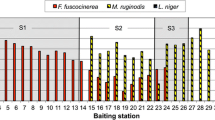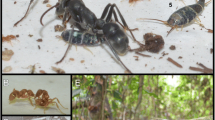Summary
Observations on the yellow antsLasius flavus De Geer were carried on by the author in Western Siberia, Tuva, Khakassia, the Altai and the Tien Shan Mountains.
The yellow ants, as most of the ant species, lead two modes of social life: they may have either single, not connected with each other nests, or friendly, closely built nests, which form large colonies. The colonies ofL. flavus often occupy large territories, where they built hundreds and even thousands of nests. These colonies frequently become habitats of numerous species of other ants. They built their nests on the mounds ofL. flavus and penetrating into the channels, gradually destroy the hosts. The colonies ofL. flavus are ouster not by single nests, but mainly by mutually related colonies of other ant species. Occupying a nest of the hosts of this territory, they come into contact with each other and become hostile. Thus colonies ofL. flavus become the theatre of struggle between nest colonies of other ant species; this fact has been observed as a widely spread natural phenomenon.
Résumé
L'auteur rapporte ses observations concernant leLasius jaune —Lasius flavus De Geer —, effectuées dans l'ouest de la Sibérie, à Touva, en Abkhasie, dans les contrées de l'Altaï et dans les montagnes du Tian-Chan.
LeLasius jaune, comme la plupart des fourmis, a la propriété de posséder un habitat en commun sous deux formes: des fourmilières isolées n'ayant aucun rapport entre elles et des fourmilières vivant en bonne entente dans un voisinage proche au sein d'importantes colonies. Les colonies duLasius recouvrent la plupart du temps d'immenses étendues occupées par des centaines et même des milliers de fourmilières.
Ces colonies sont souvent envahies par des fourmis d'un grand nombre d'autres espèces. Ces dernières établissent leur habitat sur celui desLasius jaunes et, s'introduisant par les passages de leur construction, en extermine peu à peu les habitants. Le délogement des colonies deLasius jaunes n'est pas le fait des fourmilières isolées; il est essentiellement dû à l'envahissement par d'autres fourmilières d'espèces apparentées. Ces dernières, occupant progressivement le territoire conquis, se trouvent bientôt en contact qui dégénère en antagonisme agressif. Ainsi, les colonies deLasius jaune se trouvent être le théâtre de la lutte entre fourmilières de diverses espèces; ce phénomène est l'expression d'une loi générale.
Similar content being viewed by others
Author information
Authors and Affiliations
Rights and permissions
About this article
Cite this article
Marikovsky, P.I. Colonies of yellow ants (Lasius flavus de Geer) as theatre of struggle between nest colonies of other ant species. Ins. Soc 12, 63–70 (1965). https://doi.org/10.1007/BF02223516
Issue Date:
DOI: https://doi.org/10.1007/BF02223516




